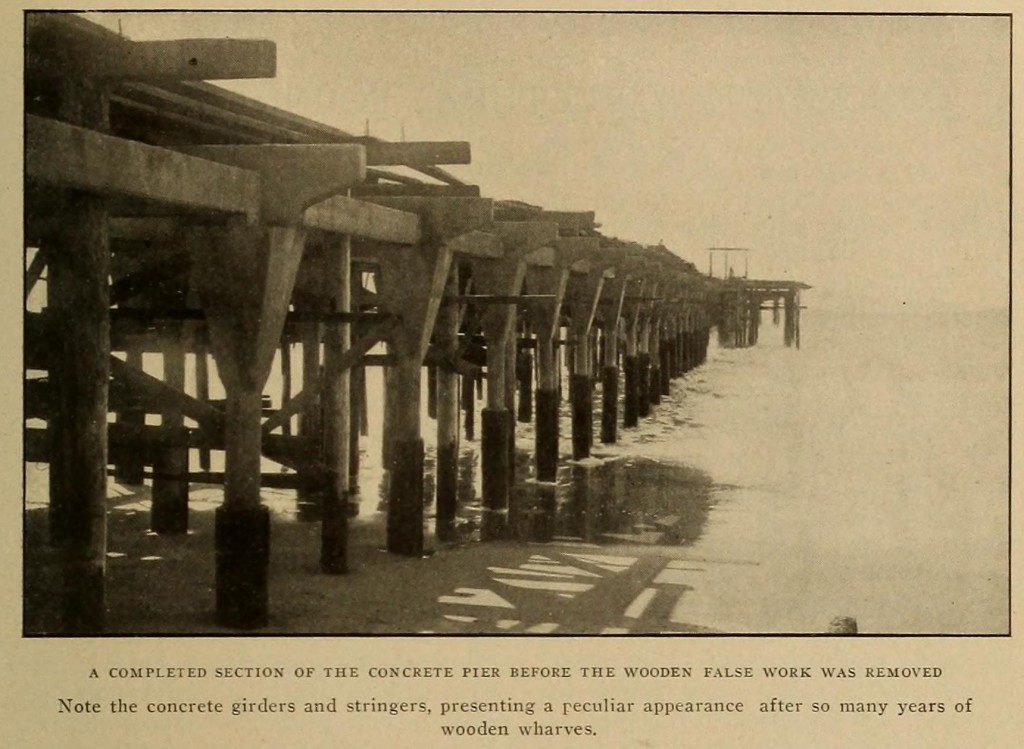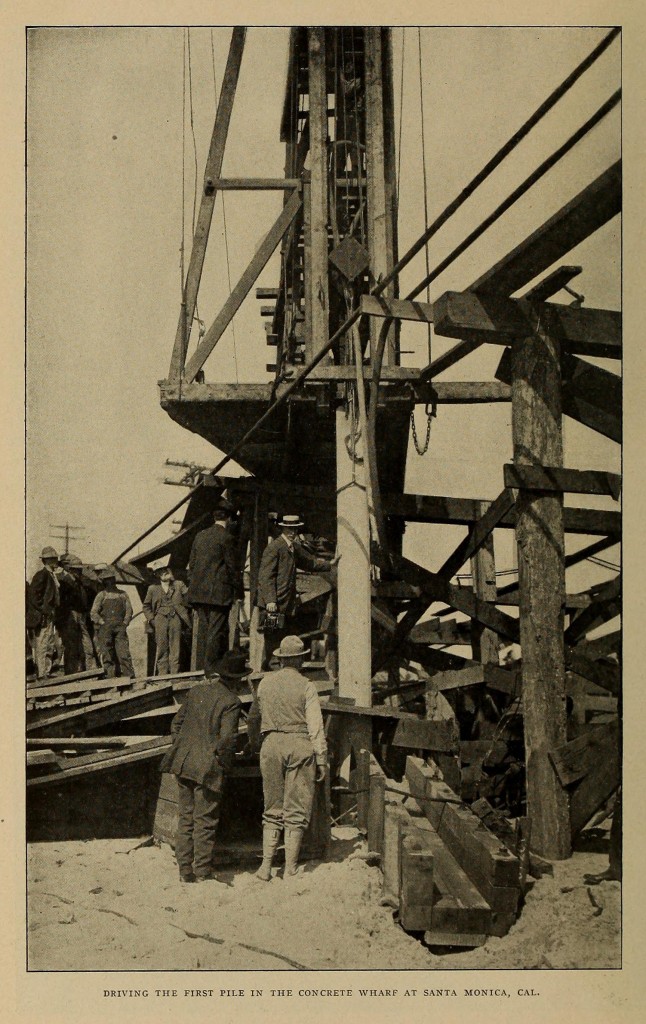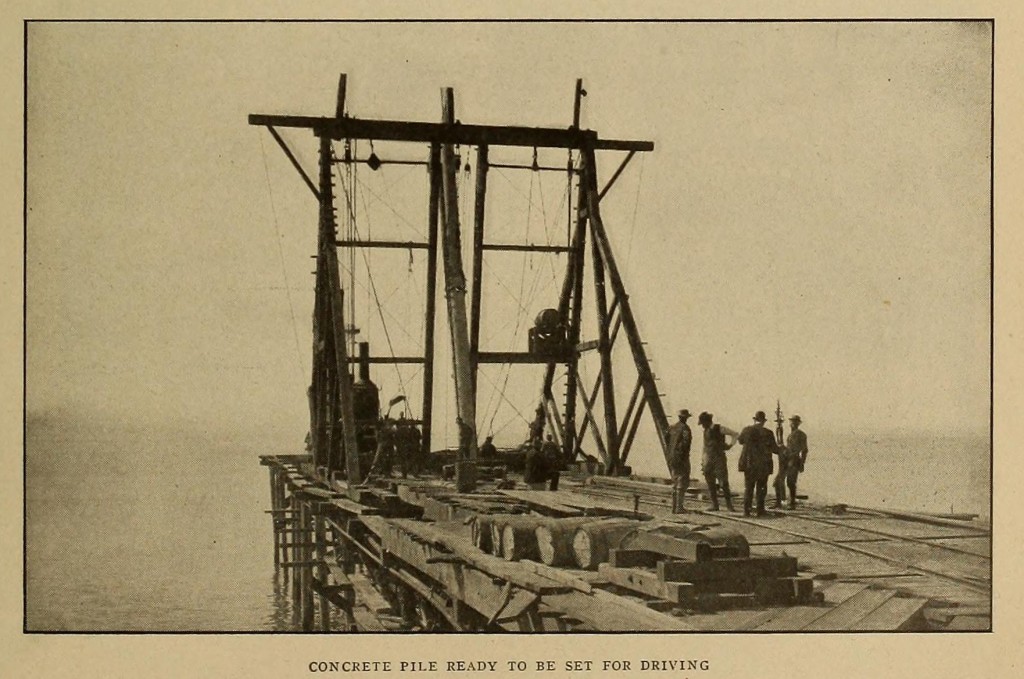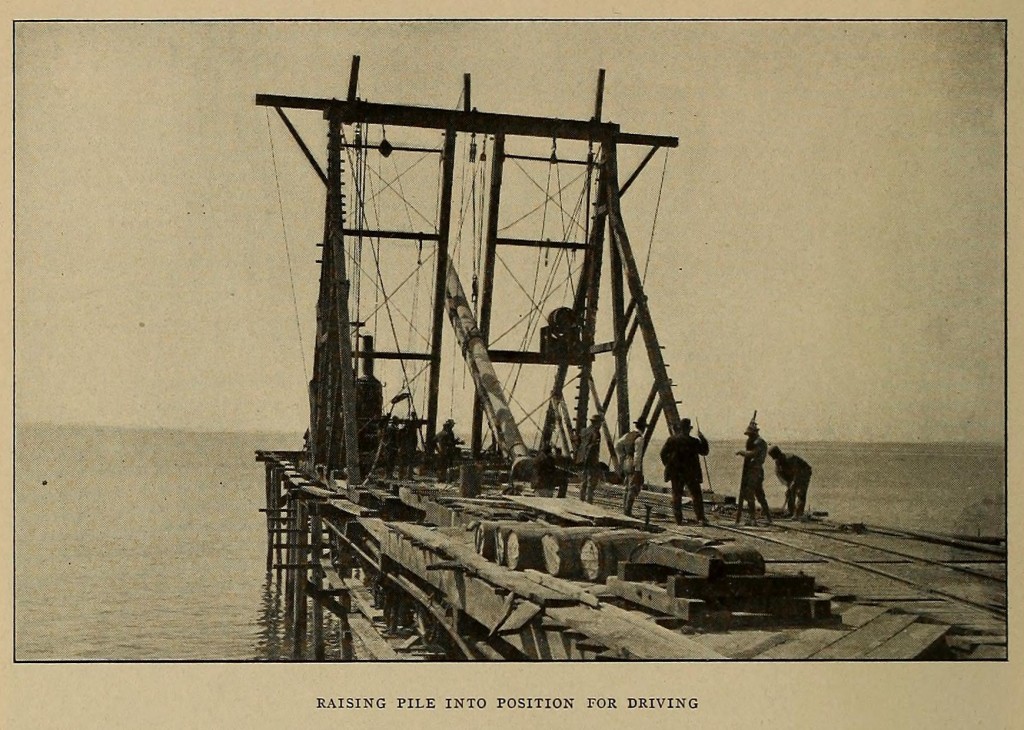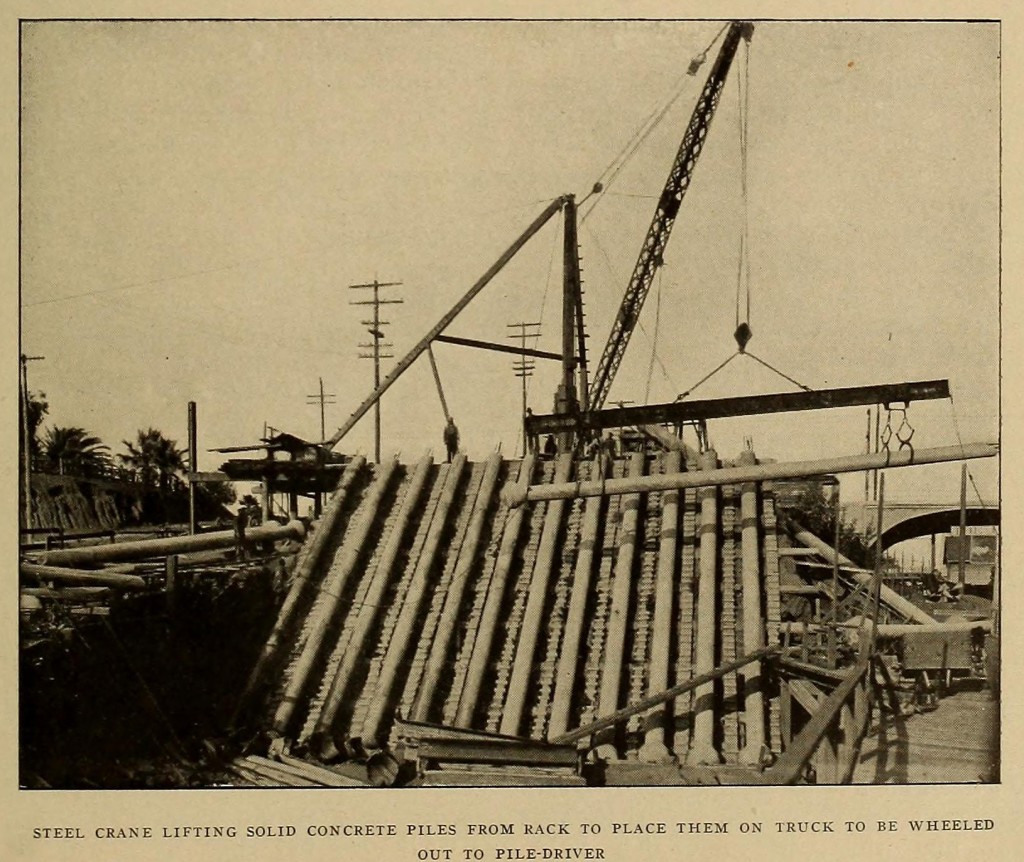Santa Monica Pier Design and Contstruction – The 100 Year Old Landmark
[Reprinted from an article in Cassier’s Magazine November 1909 titled “Concrete Pier Construction on the Pacific Coast. The new Reinforced-concrete Wharf at Santa Monica by H. H. Dunn]
In view of the widely extending use of sand, lime and cement in construction, from the dwelling cast in moulds to the towering skyscraper knit together with slight bars of steel, it is of especial interest to note the successful completion of the first concrete pier on the Pacific Coast of America.
Extending in a straight line 1,600 feet out into the Pacific Ocean, this latest example in wharf construction has just been completed at Santa Monica, where the longest wharf in the world — the Southern Pacific Railroad’s pier at Port Los Angeles — is already located. So far — and the piles of the landward end of the new pier have been in position for several months — the sea has not made the slightest impression on the concrete posts. Teredos, those sea worms which make the life of the wharf builder a continuous nightmare, are powerless to penetrate the new piles; barnacles cling to them in small numbers, but can do no damage, while the strongest waves of the sea break aimlessly against the smooth concrete and without deleterious results to the wharf which they support.
All the girders, bents, stringers, struts and piles in this pier are of concrete. Twenty-one feet above mean tide level these concrete “timbers” carry the floor of the wharf, itself also made of cement and sand. The ocean bed at the foot of Ocean Avenue, of which the pier is a continuation, is of firm, white sand, sloping seaward at an inclination of 2 feet in every 100 feet of outward distance.
The promenade which takes up the floor of the new pier is 35 feet wide over all, and it is supported on trestle bents, spaced 20 feet, centre to centre. At the end of the pier there is a large platform (40 by 90 feet) handsomely decorated with cement work and brilliantly illuminated. At two intermediate points in the length of the wharf are other platforms, similar in size, decoration and lighting. Primarily the pier was planned to be a pleasure promenade, but it will also carry an 18-inch sewer pipe and serve as a landing place for small pleasure boats from other parts of Santa Monica and from nearby beach resorts of the south coast.
Reinforced-concrete girders, 35 feet long, huge gray monoliths, rest on the trestle bents. These latter are made up of three reinforced-concrete piles, spaced 13 feet 6 inches, centre to centre. These piles set at the usual angle against the shore currents and, with their concrete girders, give a peculiar air of solidity and stability to the novel structure.
Under the platform spaces there are trestle bents also, but these are made up of seven piles, similarly placed and capped with a reinforced-concrete girder, 90 feet long, overhanging at the ends like the lintel of some great stone doorway. In themselves these 90-foot beams of cement are unique, and they have attracted fully as much attention as have the huge cylindrical piles on which the concrete pier rests.
The trestle bents just described are still more strongly united by reinforced-concrete struts 9 by 18 inches in section, their reinforcement consisting of four 1-inch steel rods, 21 feet long. The girders forming the capping for the piles are 9 by 30 inches in section, reinforced by two bars each, 1/2 by 2 1/4 inches, placed within 2 inches of the bottom of the girder; two bars, each 1/4 by 2 1/4 inches, placed within 2 inches of the top of the girder, these bars connected by 1/4 by 1-inch diagonal members and vertical members of the same size, all bolted together and solidified with three 8-inch bolts. Over each centre pile are two additional bars, 1/2 by 2 1/4 inches, 8 feet long, bolted to the top chord. In addition to this, there are, in each span, eight spacing-bolts with gas- pipe separators; and in the compression side of the overhang of the girder are two rods, 3/4 of an inch in diameter, 4 feet long.
The platform spaces are similarly reinforced, allowing greater length to the rods and bolts, owing to the greater width of the platforms, as compared to the width of the promenade.
But the chief interest among residents of Santa Monica centered in the huge piles. Prior to starting actual work on the pier, great cylindrical moulds were built on the sloping bank of the sea near the end of Ocean Avenue. In these the piles were cast vertically and in such position that a traveling crane at the landward end of the first false-structure of the pier could pick them up with ease from the point where they had been rolled out of the moulds.
Measuring 75 feet in length, and varying from 14 to 22 inches in diameter, the weight of each pile averaged more than five tons.
Each pile has a great bulb point, with which it anchors itself in the sand, which is very firm and unshifting at this point in the sea wall. Also, within each pile is a 2-inch jet pipe, down which the water was sent to sink the shaft into the bed of the ocean. When the piles were firmly set in their resting places all these jet pipes were filled with wet cement.
The reinforcement for the 14-inch pile consists of six 3/4-inch steel rods, arranged symmetrically 2 inches from the outside of the pile and bound together every 3 feet of length with No. 12 wire. Where it was found necessary to splice the rods, they were lapped 2 feet and wrapped with No. 14 wire to a 2-inch pitch. The lower ends of the rods are splayed into the bulbs, the upper ends into brackets, and carried 28 inches above the head of the piles to mesh into the reinforcement of the girder and strut. In each bracket under the strut were placed two additional rods, 9 feet 6 inches long, and of the same size as the reinforcement rods.
The reinforcement of the 18-inch pile consists of eight 3/4-inch rods; that of the 22-inch pile eight 7/8-inch rods; all other details of the 14-inch pile apply to these sizes.
After the piles were made each one was given a jacket of No. 12 steel, 9 feet long, enclosing the monolith from a point 3 feet below the line of mean low water to a point 6 feet above the same mark, thus insuring the covering also of the average high-water line. These jackets were then coated with an asphalt composi- tion to prevent rust. It should be said here, however, that under the steel sheath each pile was painted with a preparation composed of one part neat cement to six parts of water.
The piles were sunk in the sand to depths varying from 16 to 20 feet, according to the condition in which the engineer found the character of the bottom. With the aid of the water jet running down the centre of each of the concrete piles, little difficulty was experienced in getting them down, their weight being so great that only a small amount of driving was found necessary.
The stringers on which the promenade “deck” is carried, are 4 inches by 16 inches, 22 feet long, and spaced 2 feet 6 inches, centre to centre. They are anchored to the girders with half-inch steel rods. On the outside the stringers are 4 by 16 inches, but only 20 feet long, with joints butted and fished with four 3/4-inch machine bolts.
The floor pan, to hold the asphalt floor, is made of 2-inch plank, breaking all joints on the stringers. A 2 by 4-inch scantling, laid flat, was nailed to the outer edge of the planking for the asphalt covering to finish against. This covering is 4 inches thick at the centre, sloping to 2 inches at the sides. All around the wharf is a railing of 2-inch galvanized iron pipe, 42 inches high, with iron posts every 6 feet. Two rows of pipe are attached to these posts aside from the railing itself, and one of them carries fresh water, with hydrants and fire plugs at convenient distances. Thirty-four lighting poles, 18 feet high, and made from 3, 4 and 5-inch pipe, carry electric lamps for the illumination of the pier.
Two landing stages are provided at the seaward end of the pier; but these are made of wood, fastened to concrete fender piles, with concrete struts binding them together. These floats are 10 by 20 feet, and stairways lead from them up to the main floor of the pier. The fender piles mentioned are ten in number, 12 inches in diameter at the butt and driven 20 feet into the bed of the sea. They are placed in a sort of irregular semicircle around the outer end of the wharf.
The specifications embodied in the first papers looking to the construction of this wharf are of especial interest to concrete engineers and to contractors, inasmuch as their close application appears to have been a large factor in the success of the novel pier. They are as follows, quoted verbatim from the specification of Mr. Thomas H. James, city engineer of Santa Monica:
“All concrete shall be a wet mixture of one part cement and six parts aggregate, the latter consisting generally of two parts of sand and four parts of broken stone.
“The cement shall be a recognized standard brand of artificial Portland cement in satisfactory use on this coast for a period of not less than two years; it shall show an ultimate tensile strength at the end of seven days of not less than 400 pounds per square inch.
“The fineness shall be such that not more than 10 per cent, by weight shall remain on a No. 100 sieve.
“It shall develop initial set in not less than thirty minutes, but must develop hard set in not less than one hour nor more than ten hours.
“Pats of neat cement shall, in water, in air and in an atmosphere of steam, remain constant in volume.
“All tests shall be made in accordance with the methods proposed by the committee on uniform tests of the American Society of Civil Engineers. A sufficient supply of cement shall be kept on hand to permit of tests lasting twelve days.
“The sand shall be clean, coarse and sharp.
“Stone shall be a hard, durable rock, broken to a maximum size of 1 inch in any direction for use in pile construction. In all other work a maximum of 2 inches in any direction will be permitted.
“If mixed by hand, the cement and sand shall be placed in layers and mixed dry until of a uniform color; the mixture shall then be spread uniformly on the stone and turned three times, water being added to the first turning. * * * Concrete shall be placed in the forms immediately after mixing, and shall be so conveyed that there shall be no separation of ingredients.
“All steel shall be good, merchant- able steel, having an ultimate tensile strength of 50,000 to 60,000 pounds per square inch.
“All forms shall remain in place three weeks unless otherwise permitted by the engineer, in which case the concrete shall be protected from the sun and all exposed surfaces wet twice daily for three weeks after the casting.
“The asphalt pavement shall consist of a binder course 2 1/2 inches thick at the centre of the pier and 1/2 inch thick at the edges, and a wearing surface uniformly 1 1/2 inches thick.”
The binder course consists of broken stone and asphaltic cement; the wearing surface is made up as follows:
Asphaltic cement, 9 […] to 17 percent by weight
Sand 86 […] to 65 percent, by weight
Finely powdered carbonite of lime, granite, quartz, or other suitable material [of] 5 […] to 18 per cent, by weight
The contractor was not permitted to sublet any of the work without the express permission of the city engineer, and the result was that some of the finest cement work ever seen on the Pacific Coast was turned out. This, combined with the cheapness of the work and its apparent durability, though this last feature has yet to be fully proven, seems to show that Santa Monica has started a new era in ocean-pier construction.

